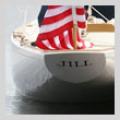Letters - Issue 100
Issue 100
When this “From the Publisher” column appeared in the April/May issue of Maine Boats, Homes & Harbors magazine (#99) it sparked a flurry of letters, several of which were published in the June/July issue (#100). We did not have room for them all, however. Hence, the original column and all the letters we received are reproduced here (the letters that did NOT appear in print are at the bottom of this page).
Letter from the Publisher
The shop is still brutally cold as I write this. While the spirit is willing to start spring fitting out, the body and the paints and adhesives are quite unwilling. Waiting for a few more warm days and nights won’t push the launching schedules too far back. In the back of the shop, Banzai, the Blue Jay that has been in our family since 1963, when my twin sister and I were twelve, started me thinking of sailing classes... our young boys... the future of sailing... are we doing enough?... the price of tea in China... (and all of this without opening a can of paint!).
When I was a boy I thoroughly enjoyed sailing classes. I loved to race sailboats—I still love to race sailboats—and that is pretty much what we did in sailing class. From what I can tell that seems to be the curriculum that still holds today. But I wonder— out of the, let’s say, 20 kids in my early classes, how many are still involved with boats today? Ten percent? Twenty-five percent? Fifty percent? More? I don’t know. My intuition tells me that it is more likely a smaller percentage than a larger one.
For me the love of boats preceded sailing classes. I used to mess around in a rowboat, exploring the backwaters of my home river, and imagining greater voyages and adventures. The boat love came from those days; the sailing classes simply built on it. And when I became burned out from competition, as I eventually did, it was the love of small boat adventuring that brought me back.
I wonder. Are we providing our children that bedrock love of boats and adventuring before we teach them the Holy Grail of boat speed? Could there be ways to include more rowing and generally messing about in boats into our children’s sailing programs? Could we hook more of them into the lifelong joys of a life spent with boats? I think we can. I’d love to hear your thoughts on the matter.
 The "legacy dory" built for every grandchild.
The "legacy dory" built for every grandchild.
Photo by Roy Heberger
The publisher asks an important set of questions all relating to children’s interest in small boats and whether we can do more to cultivate that interest (May 2008 issue, MBH&H # 99). My answer is, yes, and a double yes if the small boats are made of wood. Living in Idaho, I’m “...a beach bum on the desert, a sailor gone off course...” (from a song I wrote lamenting a decision I made to relocate away from big water). Having grown up on the south shore of Lake Ontario, boats were in my life and my blood from my earliest memories, but my children and grandchildren do not have that experience due in part to where they live. I missed the opportunity with my own children to get them into boats, lines, and knots, so for my grandchildren I’m doing something about that.
This past winter I built the prototype of what I refer to as a “legacy dory,” which I will build for each of those grand children. Currently, there are three. I want to leave something of me behind so that they know a little of who I was and of my love for boats. My main challenge will not be in the construction of the next in the series, but in how to meaningfully involve each of my grandchildren in the process. If you or your readers have any suggestions, I would benefit greatly from hearing them.
John K. Hanson, Jr.
Camden, Maine
Letters:
The Top Ten
I enjoyed your musings about kids and boats in the May 2008 issue, MBH&H #99. Per your invitation, here are some thoughts:
1. Spend time with your kids messing about and sharing the things about boats that you love—whatever that is. Most kids crave time with the significant people in their lives. Be that person. And boats are inherently one of the best playgrounds a kid of any age can have.
2. Keep it safe. Messing about isn’t fun if your kid is scared.
3. Keep it enjoyable. Messing about isn’t fun if your kid is scared of messing up. Accept that things will get rearranged, scratched, dirty, lost overboard, broken, etc. Lighten up and don’t get all Captain Bligh about it.
4. Put your kid in charge of something as soon as possible. People of all ages love feeling they’re making a meaningful contribution.
5. As soon as they’re capable, let them steer. And let them decide where to go. Everyone enjoys plotting their own course in life. And it’s a thrill for any kid to be taking the grownup somewhere for a change.
6. Be open to the kid’s interests. I’m a traditional wooden sailboat guy myself, and I’ve never had any personal interest in going fast on the water. But because my middle kid is a go-fast motorhead, we’re now the proud owners of a 1957 T-bird blue fiberglass runabout. We’re working on it together, and I expect it’ll be a hair-slicked-back-in-the-wind blast when we get it running.
7. If the kid’s interested, include him or her in the maintenance chores; it’s a great opportunity to teach important life skills. But see #3 above. And know when to quit.
8. Make it a year-round activity regardless of where you live. In the off-season spend time together reading, looking at charts, dreaming up adventures. As a result of reading Farley Mowat’s The Boat Who Wouldn’t Float and Holling C. Holling’s Paddle to the Sea, one of my sons is plotting and scheming to take our boat to the Canadian Maritimes and up the St. Lawrence to the Great Lakes as soon as he’s old enough.
9. As soon as they’re old enough and capable enough, turn ’em loose on their own. Kids have fewer opportunities these days for the kind of time on their own messing about in a rowboat that you describe. Being master of your own ship, be it ever so humble, is what growing up is all about. And no boat is any fun, nor can it make any headway, with a helicopter hovering overhead.
10. Accept that some kids just aren’t into it, or may lose interest. I know it’s hard to believe, but not everyone’s a water rat.
Camden, Maine
Jim Lartin-Drake, Carlisle, Pennsylvania
Not Much Has Changed
I thought your publisher’s letter in the May 2008 issue (MBH&H #99) about youth sailing programs was just what youngsters should be learning. I enclose an excerpt from an article by Wm. H. Taylor in the May 1946 Yachting to show how little has changed over the years.
“Personally, I wouldn’t give a dime for a championship junior racing crew unless its members were all around seamen as well,” wrote Taylor. “Even among adults, some crack racing men are regrettably poor boatmen and no seamen at all. Sloppy supervision by instructors and lack of solid grounding in the fundamentals show up all too often in junior sailing. Boats are left with water in the bilges, rigging slack, sails poorly furled, mooring lines out of the chocks. Rowboats are left with oars in the rowlocks, or brought alongside with the rowlock still standing. Boats go adrift. Many juniors seem to have no idea how to reef or furl a sail properly, or to do simple piloting. Overemphasis on racing is usually the reason. Adequate instruction in basic seamanship, coupled with close and intelligent supervision, should cure the faults, and a youngster who is persistently sloppy or careless should be ‘beached’ for a substantial period.
“One art which is sadly neglected, in clubs that are well supplied with launches, is rowing. To my mind every youngster, before being admitted to the sailing classes, should prove that he or she can row expertly; make clean, smart landings alongside boats and floats under all reasonable conditions; get in and out of a boat properly; and secure boat and gear. Most of the problems that come up in ship handling have their basic counterparts in the handling of a small boat under oars. Rowing should be as inevitable a prelude to sailing as walking is to bicycling. Sculling is an almost-lost art that would be well worth reviving, too.”
Thanks for the thoughts in your writing.
Steve Corkery, Coecles Harbor Marina & Boatyard
Shelter Island, New York
Inspired by Books
I enjoyed John Hanson’s essay on the Arthur Ransome books (MBH&H #99, May 2008). I read them as a boy, and when our daughters were of an age to be read to I wrote to Blackwell’s and ordered the lot. Little wonder that when we acquired our little sloop 20 years ago, she became the Nancy B. (I didn’t know at the time that Arthur Ransome named his boat Nancy Blackett.) Now that we have a granddaughter I am just waiting for her to get old enough to be read to. Kent Mullikin, Chapel Hill, North Carolina
Yes, Of Course Yes The "legacy dory" built for every grandchild.
The "legacy dory" built for every grandchild. Photo by Roy Heberger
Roy Heberger, Landlocked in Boise, Idaho
Just Do It
In response to your request in the May 2008 issue, MBH&H # 99, for thoughts about developing in kids a lifelong love of boats, I believe one good approach is suggested by something we’ve all heard dozens of times from 2-year-olds: “I do it myself, Mommy.” After all, don’t nearly all kids arrive on earth wanting to do it themselves? Isn’t that what most of us want ó to chart our own course in life? Unfortunately, out of the best of intentions, often to protect their kids from harm, too many parents take that most basic and fulfilling of human yearnings away from kids by using the “Don’t” word more often than the encouragement, “Go ahead and try it.”
I love boats. I built my first boat when I was 16 (I’m now 63), a canvas-covered wood frame kayak, which I have paddled over the lakes and rivers of Texas, Virginia, and Colorado. It still looks as good and is as strong today as the day I built it, requiring only an occasional refinishing. I think building it was one of the things that instilled the enduring love of boats in me.
My recommendation is not to give kids the best sailboat, or rowboat, or kayak you can afford to give them. A parent’s natural desire to give their kids the best is not always the best. Instead, get them involved in creating a boat themselves. Encourage them to build it, or restore it, or even just give it a new coat of paint. Make as much of the process as possible the result of their choices, and their efforts. Of all of the fine and expensive boats that I’ve owned over the years, nothing has ever given me the pleasure of drifting down a beautiful river in the one that I built myself.
Gary Cornwell Beaumont, Texas
















